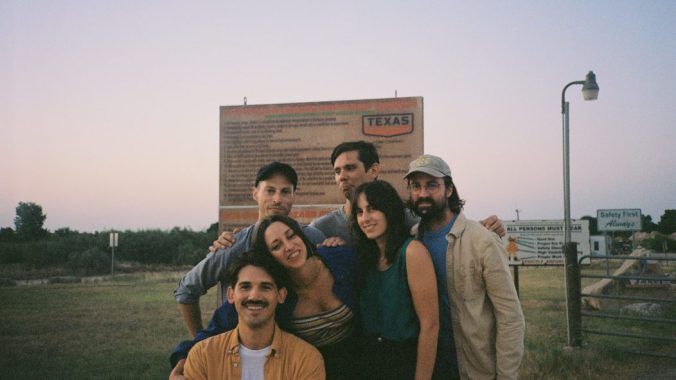Sun June and the Beautiful, Surreal Sustainability of Abstraction
Bandmates Laura Colwell and Stephen Salisbury muse on their roots, dreamlike interpretations in songwriting and the Texas outfit’s latest record, Bad Dream Jaguar.
Photo by Alex Winker
Far from the sparse Western depictions that so many associate with the South, Texas is teeming with a rich history of art. With years of legendary musicians across every genre—Willie Nelson, Stevie Ray Vaughan, Janis Joplin, Meat Loaf, Roy Orbison—it is impossible to not be inspired when you step foot in a state with a spectrum of visionary artists as diverse as it is wide. The Texas landscape has plenty to offer its creatives, too, historically and collectively and artistically—and it’s that very magic that led to Laura Colwell and Stephen Salisbury meeting each other in Austin.
Although the Texas transplants eventually bonded over music, that’s not what brought them together in the first place—it was the state capital’s bustling movie industry. Vocalist and songwriter Colwell and guitarist, vocalist and songwriter Salisbury met in the editing room of Terrence Malick’s Song to Song. Then, working as a production assistant and editor, respectively, late nights on the clock turned into joking jam sessions using Ryan Gosling’s guitar to create spoofs of songs like “Where Is My Mind?”—which became “Where Is My Life?” However, their musical endeavors stopped being a joke when the self-proclaimed “regret pop” group started adding new members, with the help of lead guitarist Michael Bain (who met the co-founding duo through a mutual friend). Sun June was pieced together through friends of friends, all of whom came from far-reaching corners of the US—North Carolina, California, New York and Chicago. Bassist Justin Harris and drummer Sarah Schultz (and, later, guitarist and vocalist Santiago Dietche) found the original trio through the spirited melting pot of the Austin music scene, where there was always an instrument within reach and someone to play with.
After playing around the live music capital of the world, in small honky tonks and dive bars, they dropped their first album in 2018, Years—a collection of live-taped songs inspired by those gigs. Then, in a feat of cosmic fate, the group’s sophomore album Somewhere miraculously wrapped in the studio the day Austin became a ghost town in 2020. The group’s third album, Bad Dream Jaguar, is the moody, atmospheric product of pandemic isolation, which required Sun June to learn how to create music together from a distance. Stripped away from the jam sessions of Somewhere and the touring life that conjured Years, Colwell and Salisbury found solace in each other during that period of seclusion—creatively and romantically.
In the spirit of life changes, Salisbury left Austin later in 2020 for North Carolina to pursue a degree in microbiology. However, even 1,300 miles away, he couldn’t help but dream of Texas. “I was missing Austin a lot. So I think there are more songs [on Bad Dream Jaguar] about Texas than I would have written otherwise,” he confesses from his home in North Carolina over Zoom. Rather than fray the six-piece, the distance created a unique remote recording process that allowed Sun June to reinvent their recording- and album-making process. Colwell and Salisbury remained deeply attached, constantly creating together through the intimacy of their relationship. At the same time, their bandmates continued working on music on their own—a necessary piece of getting through an unprecedented time. “The other band members got up to other musical projects, playing in other bands. They got experience with new musicians, which helped re-inspire them,” Salisbury adds. All in perfect timing to begin a new chapter for Sun June, Bad Dream Jaguar.
Because of some artistic neuroses across their first two albums, Sun June was measured and rehearsed, opting for perfection over spontaneity. However, with everyone spread out from each other, that space let the band create more freely the third time around. “I was overwhelmed by it at first. I had difficulty knowing what I was doing outside of the band. It gave me too much space. I was self-conscious about sending my work to the band,” Colwell admits. “I think the distance influenced how we worked together, because we had limited time. And it helped. We weren’t as precious about the music and bringing songs to the band,” she said. “I think it was good for us to be able to throw caution to the wind right as we’re about to record, learn a song or give people a few months to chew on something.”
The band quickly found a new rhythm of sending snippets of ideas back and forth to each other. A melody here, a lyric there, the occasional guitar riff and, even, the help of some outside musicians gave a new layer to the sextet’s sound. For them, this forced separation became an exciting journey of discovery. “Laura and I had some special moments in the studio, when it was just the two of us in North Carolina,” Salisbury says. “We got the best of all worlds. The album has some of the songs we recorded at home together, but we still played in the studio as a band a few times. The difference was that we hadn’t toured the material or practiced it to death. It became the first thought—best thought—which is not normally how we work. We are normally ‘first thought, we hate ourselves.’”
-

-

-

-

-

-

-

-

-

-

-

-

-

-

-

-

-

-

-

-

-

-

-

-

-

-

-

-

-

-

-

-

-

-

-

-

-

-

-

-








































